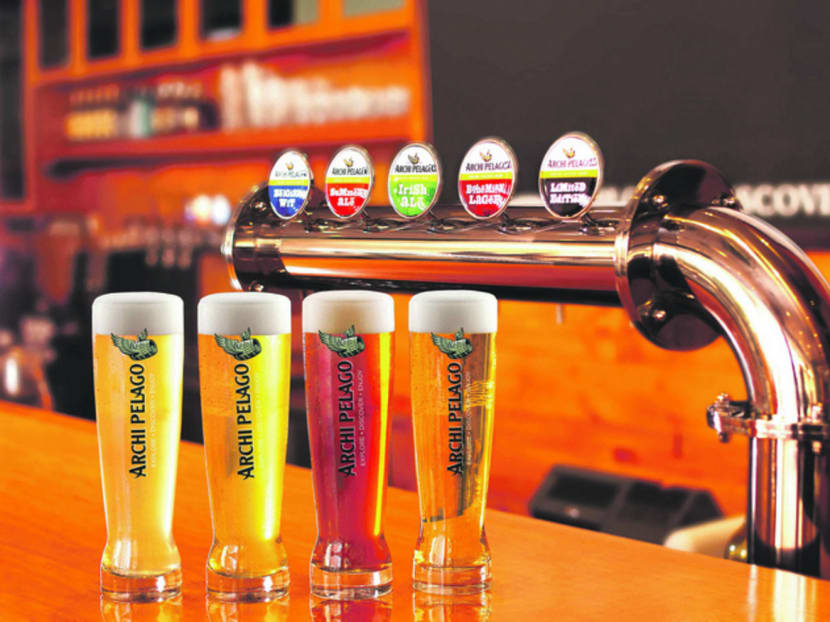Is this the right time for craft beer?
SINGAPORE — This is the right time for craft beers. At least that’s what Malcolm Davies, the head of Archipelago, Singapore’s first commercial brewery, thinks. Craft beer, if you don’t know by now, is beer that has been handcrafted by the brewers themselves. This means that the brewer can control the ingredients, such that the beers tend to have more “personality” compared with those created by bigger companies.

Archipelago's current crop of craft beers will be joined by newer variants.
SINGAPORE — This is the right time for craft beers. At least that’s what Malcolm Davies, the head of Archipelago, Singapore’s first commercial brewery, thinks. Craft beer, if you don’t know by now, is beer that has been handcrafted by the brewers themselves. This means that the brewer can control the ingredients, such that the beers tend to have more “personality” compared with those created by bigger companies.
“Our beer, for example, is fresh — we don’t pasteurise our beer,” said Davies. “At Archipelago, we make it by hand — we have to climb a ladder to the top of the fermenter while it’s still warm to put in the hops ... that’s the sort of level craft beers are at. Consumers, when they taste it, can tel there’s a lot of stuff that goes in — but it is still priced about the same.”
There are significantly more bars in Singapore serving craft beers these days, whether they’re “specialist” venues such as Boulevard Craftbeer or Smith Street Taps or your “regular” bars such as Timbre. (Around 62 bars here serve Archipelago, for example.)
“The craft beer trend is picking up quite nicely — people are talking about it,” Davies said, comparing the recent trend to the wine bar boom of the late 1990s or the whisky bar boom of the mid-2000s. “About 15 years ago, it was wine and wine bars coming up, and people were talking about smelling the grape varietals when drinking wine. Now, people are talking about what kind of hops are used in beer.
“I’m not talking about only craft drinkers, but the mainstream drinkers, who are now more concerned about the aroma and flavour of the beer. I’m really bullish about it,” he said. “The trend is growing, thanks to the new craft beer outlets here and the technology — with things such as one-way kegs (which means there is less chance of contamination) — has also helped make it easier to create these beers.”
It’s no surprise that Davies is pleased by this turn of events, which is why he can’t wait to bring out Archipelago’s revamped offerings. The company started its business way back in 1931, and although its popularity waned somewhat, the brewery came back strong with new offerings in 2006.
“Next year, the new version of the company — Archipelago 2.0 if you will — would have been running for 10 years,” said Davies. “Lucky for us, more bars are wanting Archipelago craft beers. Our variants are moving nicely with that change, such as the Summer Indian Pale Ale 5.5, which is moving quite well.
Of the company’s past efforts, Davies said: “I think we played it really safe. We had looked at the market and thought that maybe it wasn’t ready for craft beer at the time. We had craft beers, but not ‘challenging’ craft beers in any way. But I think the market has grown since 2011. And we’re taking a risk. I’m taking out Summer Ale, our biggest-selling beverage, and putting in Summer IPA, which has more malt, flavour, hops, bitters ... It’s not a ‘safe’ drink — it’s more challenging for us to do it. That’s the direction we’re taking. We’re going to make more challenging beers.”
That said, Davies acknowledged that while he wanted the beers “to stand up for themselves”, pairing craft beers with food is an option for those who aren’t into such beers or are just trying them out. Archipelago will still carry two “entry level” variants: The Belgian Wit and Bohemian Lager. “The IPA can go well with meat, and the Belgian Wit goes well with seafood — although, as I say, you can drink it without accompanying it with food. If you are introducing someone to craft beer, you can give them the Belgian Wit or Bohemian Lager to start. If you are into craft beers, you can drink the IPA or the Irish Ale. And we still have our limited edition offerings as well.”
Still, you don’t have to be a know-it-all to appreciate craft beers, said Davies. “I don’t think we ought to be beer snobs. Knowing the difference between a lager or an ale is not that important; it all boils down to whether you like the flavour or not.”







